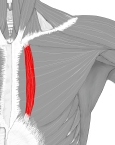胸骨筋 ( きょうこつきん、 英 : sternalis muscle )
・ 概 要 |
・ 神経 / 脈管 |
||
・ イラスト |
・ Wikipedia |
||
・ 起始 / 停止 |
・ イラスト掲載サイト |
![]()
![]()
・ 出現頻度は人種によって異なり、 「 日本人では約 10 %、白人では約 2~4 % ほど」 となる。 ( 船戸和也のHP )
Wikipediaには以下のような解説文が見られる。
「 Cadaveric studies showed that the sternalis muscle has a mean prevalence of around 7.8% in the population[7] with the range from 0.5% to 23.5%.[8] It has a slightly higher incidence in females.」
・ cadaveric : 死体の ・ prevalence : 普及 ・ incidence : 発生
![]()
「 日本人体解剖学 」 には以下のような解説が見られる。
「 胸骨筋の腱の上方が胸鎖乳突筋に連なることがある。筋の発育がよい時は皮膚の上から認められる。」
・ 筋の走行にはいろいろなパターンが認められる。
![]()
![]()
【 起 始 】 : 「 普通は腹直筋鞘あるいは第3~7肋軟骨 」 ( 船戸和也のHP )
【 停 止 】 : 「 多くは胸鎖乳突筋か胸筋筋膜 」 ( 船戸和也のHP )
![]()
・ 神 経 : 「 常に胸筋神経または肋間神経の枝によって支配される。」 ( 船戸和也のHP )
・ 脈 管 :
The sternalis muscle is an anatomical variation that lies in front of the sternal end of the pectoralis major parallel to the margin of the sternum. The sternalis muscle may be a variation of the pectoralis major or of the rectus abdominis.
【 Structure 】
The sternalis is a muscle that runs along the anterior aspect of the body of the sternum. It lies superficially and parallel to the sternum. Its origin and insertion are variable. The sternalis muscle often originates from the upper part of the sternum and can display varying insertions such as the pectoral fascia, lower ribs, costal cartilages, rectus sheath, aponeurosis of the abdominal external oblique muscle. There is still a great deal of disagreement about its innervation and its embryonic origin.
In a review, it was reported that the muscle was innervated by the external or internal thoracic nerves in 55% of the cases, by the intercostal nerves in 43% of the cases, while the remaining cases were supplied by both nerves. However, innervation by the pectoral nerves has also been reported. This appears to indicate that the sternalis is not always derived from the same embryonic origin.
【 Prevalence 】
Cadaveric studies showed that the sternalis muscle has a mean prevalence of around 7.8% in the population with the range from 0.5% to 23.5%. It has a slightly higher incidence in females.[1] Though, It was proposed that a possible reason for the high prevalence may result from the existence of small, ill-defined or tendinous fibres, which could be misidentified for a sternalis muscle.
【 語 句 】
・ pectoralis major : 大胸筋 ・ sternum : 胸骨 ・ rectus abdominis : 腹直筋 ・ pectoral fascia : 胸筋筋膜 ・ costal cartilages : 肋軟骨 ・ rectus sheath : 腹直筋鞘 ・ aponeurosis : 腱膜 ・ abdominal external oblique muscle. : 外腹斜筋 ・ embryonic : 胎生の ・ external or internal thoracic nerves : 外胸または内胸神経 ・ intercostal nerves : 肋間神経 ・ cadaveric : 死体の ・ incidence : 発生 ・ misidentify : 誤認する
【 Variations 】
A recent study classified the sternalis into three types depending on morphology.
- Type I ( single head and single belly )
- Type II ( double-headed/multi-headed )
- Type III ( double-bellied/multi-bellied )
Type I, the single head and single belly was seen in the majority of reported cases (58.5%), type II in 18.1%, and type III in 23.4%.
In addition to the above classification, triple-bellied/double-headed sternalis has also been reported.
【 Function 】
There is no apparent physiological function of the sternalis muscle.[11] However, there are many theories for a function. It may function as a proprioceptive sensor for thoracic wall movements.[12] It may also take part in the movement of the shoulder joint or have an additional role in elevation of the chest wall.
【 語 句 】
・ morphology : 形態学 ・ proprioceptive : 固有受容性の
![]()



